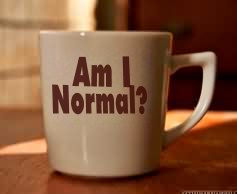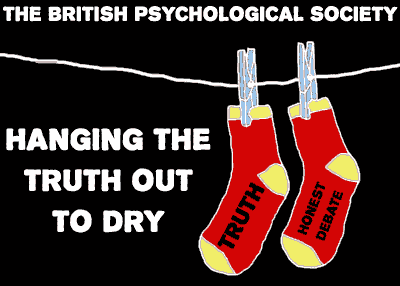 Following my last posting on the abuse of science and of an individual - Lisa Blakemore Brown - by the British Psychological Society, I thought it appropriate to launch into a more general rant about the abuse of psychiatric diagnosis to suppress scientific discussion. For collated posts on the case of Lisa Blakemore Brown see here.
Following my last posting on the abuse of science and of an individual - Lisa Blakemore Brown - by the British Psychological Society, I thought it appropriate to launch into a more general rant about the abuse of psychiatric diagnosis to suppress scientific discussion. For collated posts on the case of Lisa Blakemore Brown see here.King's College London claim to know whether individuals are mentally "normal". See this fascinating study - Am I normal? - from King's College. Norms were reported for the 21-item PDI psychometric test for delusional ideation. Although the deluded sample of schizotypal inpatients scored significantly higher than "normal" individuals, the range of scores overlapped considerably, with 11 percent of healthy adults scoring higher than the mean of the deluded group.
Other silly research reported from King's College London suggests that "one in three people in the UK regularly suffers paranoid or suspicious fears" based on the King's College definition of paranoia that runs along the lines of "Paranoid thinking is the suspicion that other people intend to do us harm." According to this wonderful research (and the accompanying book "Overcoming Paranoid and Suspicious Thoughts"):
- 40 per cent of people regularly worry that negative comments are being made about them
- 27 per cent think that people deliberately try to irritate them
- 20 per cent worry about being observed or followed
- 10 per cent think that someone has it in for them
- 5 per cent worry that there's a conspiracy to harm them.
But what if people really do "intend to do us (or society) harm"? Paranoia (as incorrectly defined above) is a normal human defense mechanism designed to protect us against harm. So is fear. Protective mechanisms can be influenced by disease. But it is necessary to know the normal range of human response to bullying, and to confirm that paranoid "delusions" are in fact false before diagnosing mental illness. Sadly the British Psychological Society appear unconcerned about reality in their assertions of paranoia (read). Psychiatric labelling (such as querulous paranoia) can be a potent form of abuse. Querulous paranoia is the disease of asking too many difficult questions.
The British Psychological Society appear to endorse tests for paranoia along the lines of those discussed by Dr Rita Pal when she faced accusations of mental illness after pointing to deaths on a geriatric ward and the subsequent cover-up. After causing the target some considerable stress by obfuscating and ignoring concerns, a test along the lines of the one below can sometimes prove diagnostically helpful.
 Look at the picture of two dolphins jumping out of the water in tandem. Research has shown that the more differences you notice between the two dolphins, the more paranoid you are. This is attributed to the concentration on minute details, distress and preoccupation induced by those in power pretending not to hear what you are saying. It also serves as an excellent test to divert attention from fiddled research involving drugs.
Look at the picture of two dolphins jumping out of the water in tandem. Research has shown that the more differences you notice between the two dolphins, the more paranoid you are. This is attributed to the concentration on minute details, distress and preoccupation induced by those in power pretending not to hear what you are saying. It also serves as an excellent test to divert attention from fiddled research involving drugs.Such highly useful tests to detect, treat and remove the "mentally ill" from the population derives from the same highly developed system of scientific psychology and psychiatry that gave us Teenscreen (imposed screening tests in the USA to detect, drug and sometimes kill normal children - Link), hidden information about the antipsychotic drug Zyprexa, and the despicable attempts to hide away information about suicide in antidepressant drug trials [Link] [Link].
It is both notable and shameful that the neither the General Medical Council nor the British Psychological Society have uttered a peep about these scandals. They have instead colluded to hide away concerns about the science upon which we as doctors rely [Link] [Link]. The UK drugs regulator, the MHRA has colluded with industry attempts to pervert science, and has failed to address many important matters brought to their attention [Link] [Link] [Link]. Instead they bully and abuse those who raise concerns, while never dealing plausibly with the concerns raised. Our patients and the public suffer in the process - but these professional bodies have little interest in honest science, honest debate or the welfare of patients.
The British Psychological Society need to do some serious explaining.
For some good essays on brilliance and madness see The Icarus Project.
Earlier|Later|Main Page
 Many bloggers have been writing about the case of Lisa Blakemore Brown and the shameful attempt by the British Psychological Society to have her pronounced "mentally disturbed" and "unfit to practice" (
Many bloggers have been writing about the case of Lisa Blakemore Brown and the shameful attempt by the British Psychological Society to have her pronounced "mentally disturbed" and "unfit to practice" ( What exactly is the role of the British Psychological Society (the representative body for psychology and psychologists in the UK)? Bloggers have been writing about the apparent attempt by the BPS to discredit the respected psychologist Lisa Blakemore-Brown and to have her officially pronounced "mentally disturbed" and "unfit to practice" (
What exactly is the role of the British Psychological Society (the representative body for psychology and psychologists in the UK)? Bloggers have been writing about the apparent attempt by the BPS to discredit the respected psychologist Lisa Blakemore-Brown and to have her officially pronounced "mentally disturbed" and "unfit to practice" (